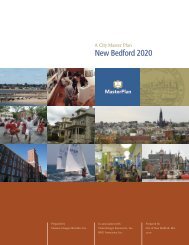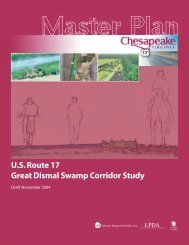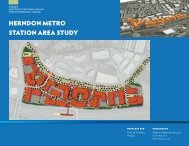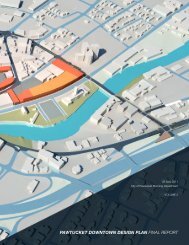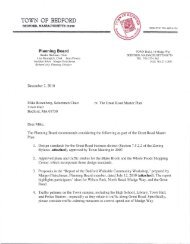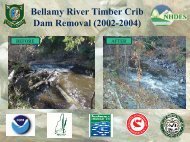Final Report - VHB.com
Final Report - VHB.com
Final Report - VHB.com
Create successful ePaper yourself
Turn your PDF publications into a flip-book with our unique Google optimized e-Paper software.
Table 5.1-1. Environmental Evaluation Metrics<br />
Resource/Impact<br />
Wetlands<br />
Water Quality<br />
Floodplains<br />
Aquifer<br />
Farmland<br />
Rare, Threatened, Endangered Species/Habitat<br />
Parkland & Recreation<br />
ROW Displacement<br />
Historic/Archeological Resources<br />
Hazardous Waste<br />
Construction Cost<br />
ROW Cost<br />
Estimated Annual Tax Loss<br />
Metric<br />
Acres of Dredge/Fill<br />
Number of Stream Crossings<br />
Acres of New Pavement<br />
Acres of New Pavement<br />
Acres of Disturbance<br />
Acres of Disturbance<br />
Acres of Disturbance<br />
Within the Proposed Project Footprint<br />
Acres of Full Acquisition<br />
Acres of Partial Acquisition<br />
Number of Known Archeological Sites<br />
Number of Standing Potential Structures<br />
Within the Proposed Project Footprint<br />
2010 Dollars<br />
2010 Dollars<br />
2010 Dollars<br />
5.2 Options Evaluation<br />
This section summarizes evaluation results for each strategy and option considered<br />
in this Feasibility Study, as well as evaluation results for the No Action Option.<br />
Figure 5-1 shows the 2035 DHV LOS for each option. Table 5.1-2 tabulates impacts<br />
and costs of each option and provides a green, yellow, or red rating to demonstrate<br />
how well each option meets the objectives of the Study.<br />
Section 5.2.2 describes the potential effect of the various TDM measures on peak<br />
traffic demands (i.e., DHV) in the Study Area. As discussed in Chapter 4,<br />
supplemental analyses were performed for each Build Option considering the<br />
implementation of an aggressive TDM program in the Study Area and region. The<br />
level of improvement in traffic operations associated with the TDM reduction in<br />
DHV is described for each applicable Build Option.<br />
5.2.1 No Action<br />
The No Action Option is the continuation and perpetuation of the existing<br />
transportation infrastructure in the Study Area. Therefore, the No Action analysis<br />
scenario does not consider any physical roadway or intersection improvements in the<br />
Study Area (except those previously discussed in Chapter 3). However, it assumes<br />
that traffic volumes will continue to grow to the design year 2035, including<br />
redevelopment of the NASB and Topsham Annex. As shown in Figure 5-1, the No<br />
Action Option results in the substantial degradation of traffic operations at eight of<br />
the Study Area signalized intersections along State Route 196, Pleasant Street, and<br />
Conclusions 143



